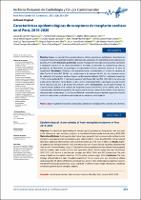| dc.contributor.author | Polo Lecca, Gracia del Carmen | |
| dc.contributor.author | Soplopuco Palacios, Franz Ronald | |
| dc.contributor.author | Alarco León, Walter Alberto | |
| dc.contributor.author | Aguirre Zurita, Oscar Nelson | |
| dc.contributor.author | Aguilar Carranza, Cristian | |
| dc.contributor.author | Villarroel Villa, Ruth Eneida | |
| dc.contributor.author | Prado Gómez, Tommy Leonel | |
| dc.contributor.author | Tapia Leonardo, José Luis | |
| dc.contributor.author | Lescano Alva, Miguel Ángel | |
| dc.contributor.author | Robles Velarde, Víctor Justo | |
| dc.contributor.author | Morón Castro, Julio Alberto | |
| dc.contributor.author | Donayre Moquillaza, Yulma | |
| dc.contributor.author | Colque Rojas, Teresa | |
| dc.contributor.author | Palma Ortecho, Luis Javier | |
| dc.contributor.author | Gálvez Caballero, David Germán | |
| dc.date.accessioned | 2022-09-30T19:49:13Z | |
| dc.date.available | 2022-09-30T19:49:13Z | |
| dc.date.issued | 2021-12-31 | |
| dc.identifier.citation | Archivos Peruanos de Cardiología y Cirugía Cardiovascular; 2021; 2(4). | es_PE |
| dc.identifier.issn | 2708-7212 | |
| dc.identifier.uri | https://hdl.handle.net/20.500.12959/2864 | |
| dc.description.abstract | Objetivo. Evaluar las características epidemiológicas, clínicas, quirúrgicas, patológicas y desenlaces en
el seguimiento de los pacientes receptores de trasplante cardiaco en el Instituto Nacional Cardiovascular
durante 2010-2020. Materiales y métodos. Estudio retrospectivo descriptivo de pacientes sometidos
a trasplante cardiaco en un centro de referencia nacional, se describen las características clínicas,
quirúrgicas, de laboratorio, de patología y la supervivencia de los pacientes hasta los 10 años de
seguimiento. Resultados. Ochenta y seis pacientes fueron trasplantados en 10 años, la mediana de
edad fue de 41 años (RIQ 28-56), con predominancia de varones (66,3%). Las tres primeras causas
de indicación de trasplante cardiaco fueron: cardiomiopatía dilatada (48,9%), cardiopatía isquémica
(17,4%) y miocarditis (6,9%). El tiempo de isquemia total fue de 160 min (RIQ 129,7-233,5). La sobrevida
al año, cinco y diez años fue de 84,8%, 73,6% y 65,7%, respectivamente. La principal causa de muerte
fue la infecciosa (39,1%) y de origen desconocido (26%). Conclusiones. La principal etiología de
la insuficiencia cardiaca en el receptor de trasplante cardiaco en el Perú, en los últimos años, fue la
cardiomiopatía dilatada no isquémica. Se observa que la tasa de sobrevida fue similar a la de registros
internacionales; sin embargo, la tasa de mortalidad de causa infecciosa y muerte de origen desconocido
es alta, lo cual plantea un desafío en el manejo de los pacientes postrasplante. | es_PE |
| dc.description.abstract | Objective. To evaluate the epidemiological, clinical, surgical, pathological characteristics and outcomes
in the follow-up of heart transplant recipients at the National Cardiovascular Institute during 2010-2020.
Material and Methods. A retrospective descriptive study was performed by reviewing the medical records
of patients undergoing heart transplantation at a national referral center, describing the clinical, surgical,
laboratory, pathology characteristics and survival of patients up to 10 years of follow-up. Results. Eightysix
patients were transplanted in 10 years, the median age was 41 years (RIQ 28-56), being predominantly
male (66.3%). The three leading causes of indication for heart transplantation were: dilated cardiomyopathy
(48.9%), ischemic heart disease (17.4%), and myocarditis (6.9%). Total ischemia time was 160 minutes
(RIQ 129.7-233.5). Survival at one, five, and ten years was 84.8%, 73.6%, and 65.7% respectively. The main
cause of death was non-cardiac: infectious (39.1%) and of unknown origin (26%). Conclusions. The main
etiology of heart failure in heart transplant recipients in Peru in recent years was nonischemic dilated
cardiomyopathy. We observed that the survival rate was similar to that of international registries; however,
the rate of mortality due to infectious causes and death of unknown origin is high, which poses a challenge
in the management of post-transplant patients. | es_PE |
| dc.format | application/pdf | es_PE |
| dc.language.iso | spa | es_PE |
| dc.publisher | Instituto Nacional Cardiovascular - INCOR | es_PE |
| dc.relation.uri | https://apcyccv.org.pe/index.php/apccc/article/view/187 | es_PE |
| dc.rights | info:eu-repo/semantics/openAccess | es_PE |
| dc.rights.uri | https://creativecommons.org/licenses/by-nc-sa/4.0/ | es_PE |
| dc.subject | Trasplante de corazón | es_PE |
| dc.subject | Cardiopatías | es_PE |
| dc.subject | Sobrevida | es_PE |
| dc.subject | Mortalidad | es_PE |
| dc.subject | Perú | es_PE |
| dc.subject | Heart transplantation | es_PE |
| dc.subject | Heart diseases | es_PE |
| dc.subject | Survival | es_PE |
| dc.subject | Mortality | es_PE |
| dc.title | Características epidemiológicas de receptores de trasplante cardiaco en el Perú, 2010-2020 | es_PE |
| dc.title.alternative | Epidemiological characteristics of heart transplant recipients in Peru 2010-2020 | es_PE |
| dc.type | info:eu-repo/semantics/article | es_PE |
| dc.subject.ocde | https://purl.org/pe-repo/ocde/ford#3.03.08 | es_PE |
| dc.subject.ocde | https://purl.org/pe-repo/ocde/ford#3.03.09 | es_PE |
| dc.subject.ocde | https://purl.org/pe-repo/ocde/ford#3.02.04 | es_PE |
| dc.identifier.doi | https://doi.org/10.47487/apcyccv.v2i4.187 | |






